Updated 11 months ago
Best solar monitoring systems for 2025
Written by
Ben Zientara
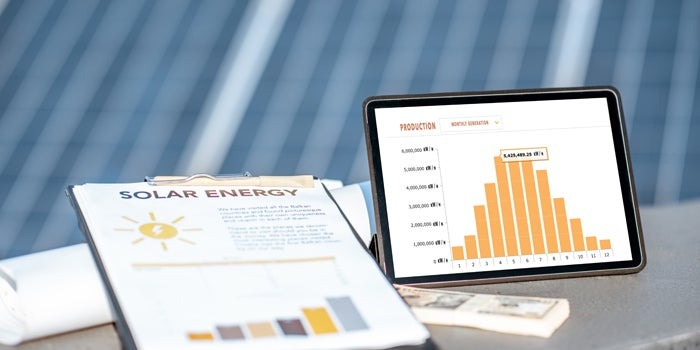
Find out what solar panels cost in your area
Solar panels sit on your roof for decades, silently making electricity from the sun, saving you money and saving the planet a little bit each day. Unfortunately, they’re also silent when they’re not making electricity, for example due to a wiring problem. To make sure your system is working properly, you need a way to check up on them.
Here are the best solar monitoring systems on the market:
Enphase Enlighten
mySolarEdge
Tesla app
SMA SunnyPortal
If you haven’t yet installed solar panels, this may determine your choice between installers, based on what solution they use. If you already have a solar installation but have no way to monitor it, this guide can help you choose a solution that’s right for you.
Key takeaways
-
Solar monitoring systems show real-time and historical solar production data.
-
The best systems can track the production of individual solar modules within an array and help identify problems before they wind up costing you a lot of money.
-
If you’re the kind of person who needs the additional functionality, Enphase’s monitoring system is second-to-none.
-
If your solar panels didn’t come with monitoring, there are aftermarket solutions to help you track solar production.
What are solar monitoring systems used for?
Solar monitoring systems provide a real-time snapshot of solar energy production data from your home solar system.
A good monitoring system can tell you when one or more panels (aka “modules”) isn’t producing as much energy as others, or whether there’s some sort of electrical fault causing you to miss out on precious kilowatt-hours (kWh).
You can use solar monitoring to track your system’s performance over time, assist in troubleshooting various problems, track your solar investment’s financial performance, and give you peace of mind that everything is working as it should.
Types of solar panel monitoring systems
There are three main types of solar monitoring systems:
Solar monitoring from equipment manufacturers
Solar monitoring from your installer
Standalone home energy monitors
Each of these solutions uses hardware installed either on each solar panel or alongside a solar string inverter to record power flow, as well as software to keep a record of the flow over time - all while providing you with an interface to look up all the necessary data about your solar installation.
To make everything work together, you need the appropriate hardware, an internet connection, and a mobile app or login to a web portal.
Here’s a little more about each type of monitoring system:
Solar monitoring from equipment manufacturers
There are three major manufacturers of solar equipment that provide monitoring as part of their products:
Enphase, which makes solar microinverters
SolarEdge, which makes string inverters and DC power optimizers
SMA, which mainly offers string inverters, but has dabbled in microinverters and power optimizers
Learn more:
How they differ
The solar monitoring solutions from the first two companies offer the same value proposition: module-level monitoring capabilities with a web portal and mobile app for convenient access to your solar production data. SMA does not currently support individual module monitoring, but does offer monitoring through both web and mobile platforms.
The major differences between all three solutions have mostly to do with the cosmetic look of their apps, with minor differences in functionality. There are also important differences in the expected lifetime of the equipment.
Enphase’s microinverters come with 25-year warranties, but cost more upfront than the others.
SolarEdge systems that use a string inverter and power optimizers may be a little less expensive, but extending the inverter’s 12-year warranty (or replacing it when it fails) will cost extra.
SMA’s central inverters are the least expensive, with 5-year standard warranties and available 20-year extended warranties available for an extra charge.
Enphase Enlighten
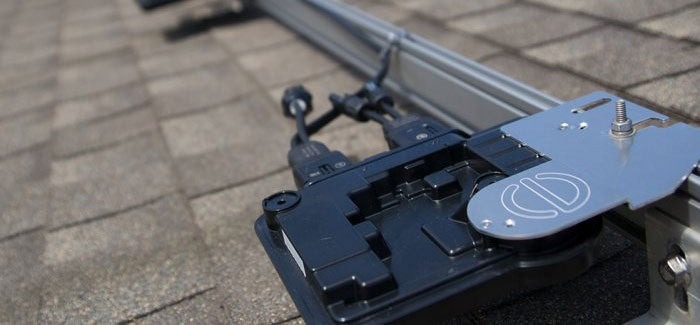
Enphase microinverters are mounted under each solar module in an array to provide power inversion and monitoring. Image source: Enphase
Enphase is perhaps the most popular solar equipment manufacturer in the world, setting the standard of the industry with their microinverter technology.
The small boxes that made them famous attach to the back of each solar module in an array and convert the DC energy output into AC energy, with a 25-year warranty to give you assurance that your system will withstand decades of use.
Enphase microinverters work with basically any solar panel on the market, and are even integrated into some newer models from major manufacturers. Microinverter technology makes it possible to maximize the output of a solar array even when one or more panels are shaded or defective.
In a traditional situation, a string of solar panels is wired together and the output of the whole string is limited by the current flowing through the least-producing panel. Microinverters provide each panel with the opportunity to produce as much electricity as it’s able.
Enphase’s microinverters also have WiFi modules that allow them to send data to the Enphase Enlighten cloud-based monitoring platform. System owners can access real-time and historical system data by using either the Enphase MyEnlighten web portal on any web-enabled device, or by downloading the Enlighten Mobile app for iOS and Android mobile devices.
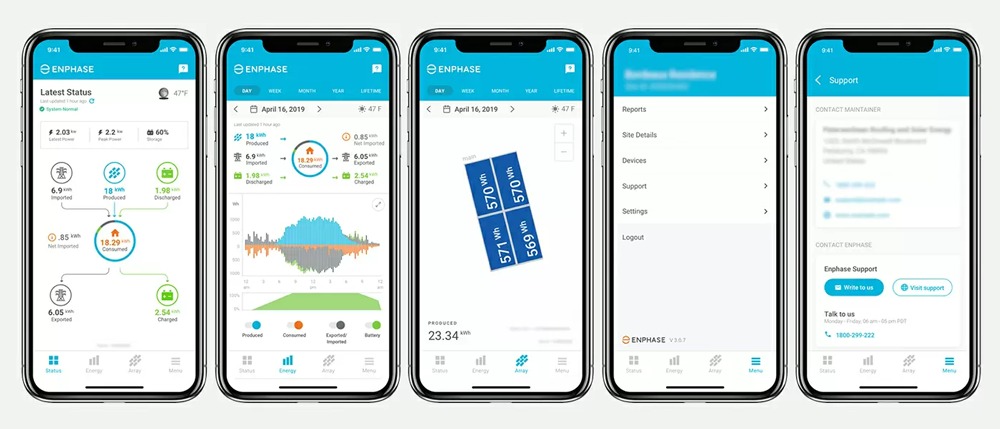
The Enlighten apps allow you to see data in multiple different ways, and link daily production records to local weather conditions.
The apps also include a virtual display of your array that color-codes modules based on how much energy they produced during the defined period. This helps you identify any modules that might not be working properly based on how much energy they produce compared to their counterparts.

The array view within the Enphase Enlighten suite shows production per-panel for the selected timeframe.
The app is also a one-stop shop of communication with your solar installer, Enphase, and your social media networks, allowing you to share production reports via email or social posts, contact your installer for troubleshooting, and even begin a warranty claim for a faulty microinverter.
All this adds up to make Enphase Enlighten the best solar panel monitoring solution on the market.
SolarEdge Monitoring
SolarEdge is a manufacturer of solar string inverters that can be paired with power optimizers attached to each solar module in an array. With the power optimizers installed, SolarEdge’s monitoring applications can track the production of individual panels over time, just like Enphase can.
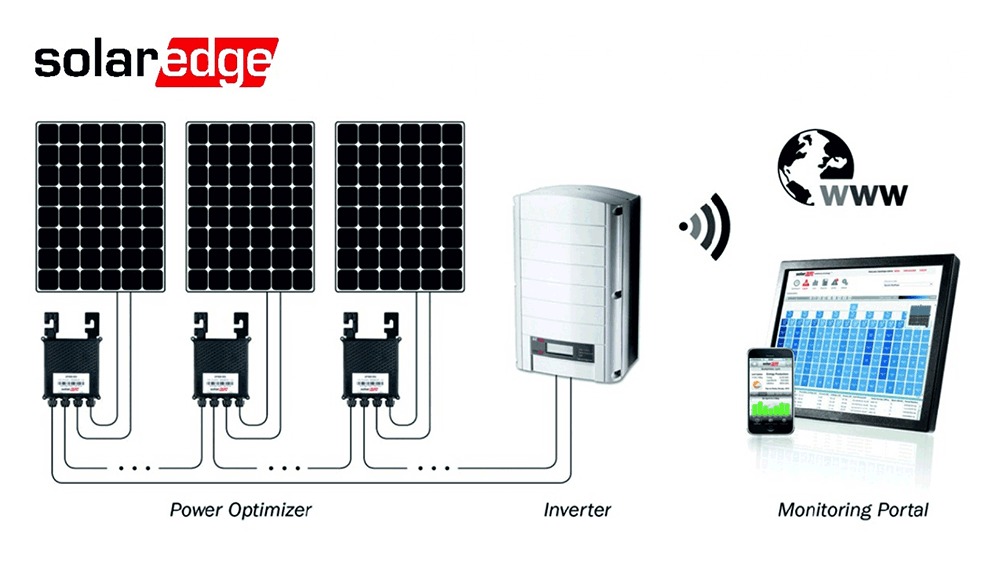
The SolarEdge suite of hardware and software. Image source: Europe Solar World
Without the optimizers, the monitoring is limited to total system output, but can still be tracked and compared over time. The system owner also has the option to retrofit their array with optimizers in order to gain more granular information.
The mySolarEdge app and web portal offer about the same functionality as Enpahase’s solution. The app can track energy produced, self-consumption, grid exports, and battery charge and discharge. It also includes remote operation of smart devices such as the company’s smart EV charger.
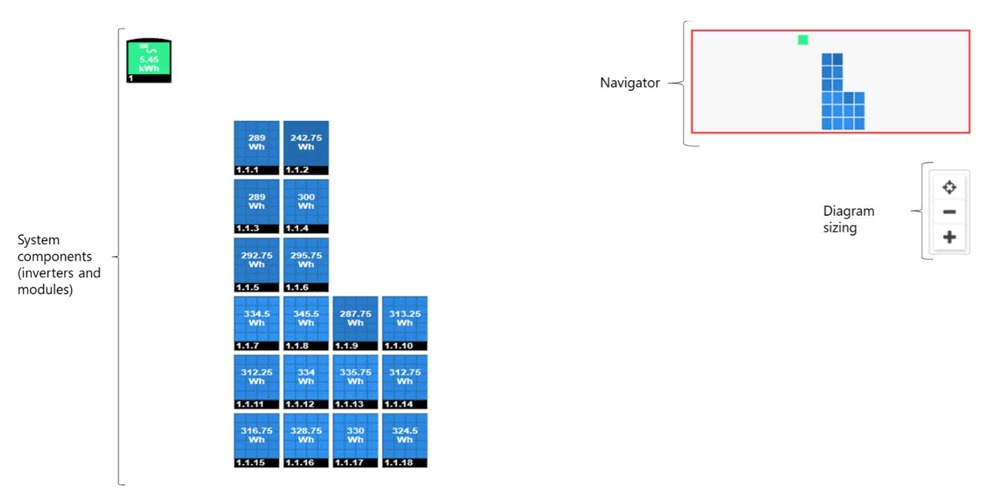
SolarEdge also shows an array view for homeowners with power optimizers.
All in all, SolarEdge competes favorably with Enphase, but the additional complication of having module-level power electronics and a central string inverter adds a bit too much complexity.
Additionally, the power optimizers carry standard 25-year warranties, while the standard warranty for SolarEdge inverters comes with a 12-year term, with extensions of as many as 25 years, available at an extra cost.
SMA SunnyPortal
SMA is a company that knows how to build top-quality solar inverters. Unfortunately, that knowledge doesn’t extend to highly attractive and user-friendly interfaces.
Honestly, their solution, called Sunny Places, is fine if you want to see the total output of a solar system, but it doesn’t wow with the kind of granular data or a polished user interface (UI) of the two previous entries in this list.
Sunny Places does have a neat feature that the other companies don’t offer: a map view that allows you to compare your system’s performance with others in your area that have agreed to share their data with the public. It’s a nice feature that helps you get a sense you’re part of a community.

SMA Sunny Places shows a whole community of SMA owners. Image source: SMA
The company also offers monitoring for its inverters through the Sunny Portal web interface and smartphone apps. These again offer pretty basic monitoring capabilities with old-looking UIs: general system information and daily, weekly, etc. production graphs. Importantly, this portal doesn’t allow for comparisons between time periods.

SMA’s interface design leaves something to be desired. Image source: SMA
SMA has developed a new version of their monitoring app called “SMA Energy”, but it seems like it’s been temporarily pulled from the app store, perhaps because reviews were not positive.
To be clear, nobody should disqualify an SMA installer from consideration solely because they prefer a better monitoring system. As we said above, the company’s inverters are top notch. And when SMA gets their act together and produces a better way to track and compare PV system production, you won’t need to buy anything else to make it work.
Solar monitoring from your installer
There are a few nationwide solar installers that offer monitoring software, but these are mostly re-skinned versions of equipment manufacturer offerings. Other nationwide installers offer web portals with day-after data, but no real-time monitoring.
The one that stands apart from the others is Tesla.
Tesla Monitoring
Tesla is known for their groundbreaking electric vehicles, sleek home batteries, and… troubled solar roof project. But what they’re perhaps best known for is impeccable modern design, and their all-in-one Tesla app is a perfect example.
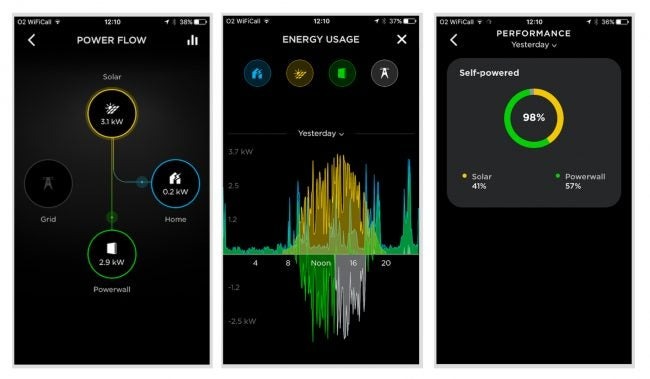
The Tesla app’s design helps display lots of important information in style. Image source: Ceiba Renewables
Tesla offers a UI that allows users to view real-time and historical solar production, home energy use, and Powerwall battery charging and discharging. The interface is slick and, to coin a phrase, “It just works.” But that slickness hides the fact that the functionality is fairly basic.
Tesla doesn't include current and historical weather data, doesn’t allow per-panel monitoring, and doesn’t have a view where you can compare one time period to the previous one. What the Tesla app does allow is the homeowner to set up their preferred method of battery backup or self-consumption to maximize financial benefits.
One big point against Tesla is that it only offers monitoring through its mobile app. There is no Tesla web portal for home solar monitoring.
Standalone home energy monitors
There are several solutions for solar monitoring provided by companies that don’t make solar equipment or install solar panels.
These solutions from companies like Sense, Curb, and Emporia have additional features that allow you to monitor energy usage in a much more granular way than solar-specific monitoring does.
Sense Monitor
Unlike rooftop hardware solutions that are tied into each solar module in an array, Sense provides add-on monitoring functionality for systems without a current monitoring solution. The Sense energy monitor itself tracks home energy consumption - even for folks without solar panels - by using AI device profiles to show where energy is being used within a home at any given time.
In order to monitor solar production, the Sense monitor must be connected to an additional two current sensors that clamp onto the wires coming from a solar inverter into your home’s main panel. Once installed and turned on, the Sense monitor immediately begins recording power flows into the home from the solar array and out to the appliances.
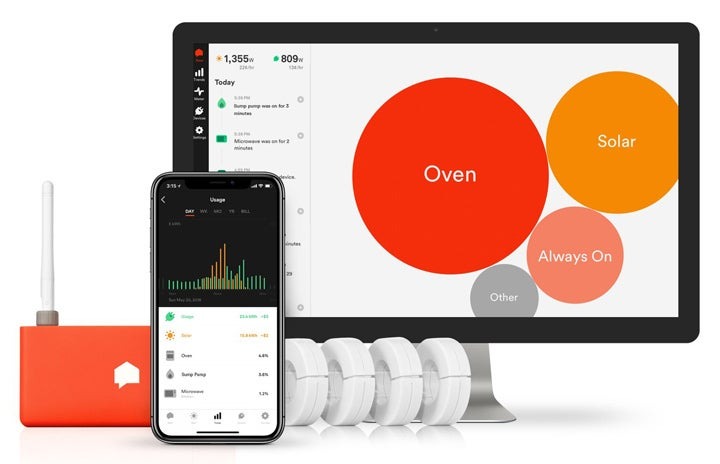
The Sense energy monitor app shows solar production compared to energy being used by your appliances.
The Sense monitoring system also records excess power sent to the grid from your solar panels, so that over time you can get an accurate record of renewable energy production, consumption, and grid export.
For folks without a monitoring setup, adding the Sense Solar energy monitor is relatively easy. It provides great information with an easy-to-use interface, and is well worth its $350 regular price. For these reasons, it gets our recommendation.
Curb and Emporia energy monitoring
Like the Sense solution, the Curb and Emporia energy monitor boxes attach to the inside of your home’s main breaker panel and use current transformer sensors (CTs) to detect energy flowing through the wires that connect to your home’s circuits.
Unlike Sense, neither Curb nor Emporia use AI to detect appliances by their usage profile. Instead, they use CTs attached to each of your circuits, meaning you get usage data for each one individually.
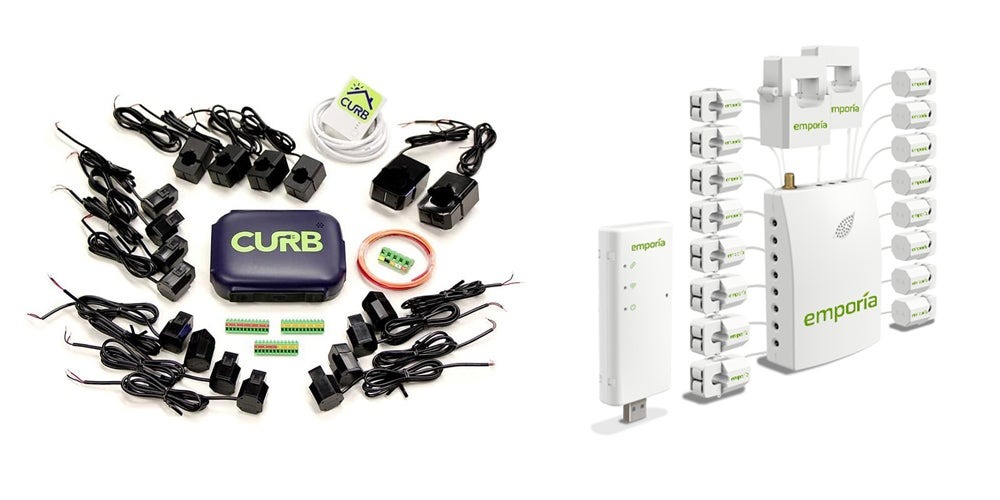
The Curb and Emporia monitors have similar parts and functionality. Images: Curb/Emporia
These individual connections allow for more accurate monitoring of each circuit, but they also result in a much more complex installation process. These solutions can monitor your incoming solar energy and outgoing energy to circuits like the washer and dryer, air conditioner, or EV charging.
All this sounds great, but you might have a tough time buying a Curb monitor. As of this writing, they’re sold out on Amazon and not available through the Curb website, either. Emporia’s gen 2 monitor is available for sale, so if you want to choose this path, find an electrician who can do the work and start your solar monitoring journey!
On the plus side for Emporia, its sensors can provide more accurate data about what’s happening on any given circuit in your home than Sense can. It’s also quite a bit cheaper, at $150 retail for a unit with 8 sensors.
Unfortunately, there are the problems of complex installation and the lack of AI that identifies specific appliances. Emporia’s app is also not quite where it needs to be yet, but the developers are actively working on updates. For these reasons, it’s worth watching for updates and discussing installation costs with an electrician.
The bottom line when it comes to solar monitoring
No matter what solution you choose, solar monitoring has two basic functions: making sure your system is producing solar power and comparing that production over time to what you expected it to be. All other functions described above are nice to have, but not essential.
If having the best monitoring system is important to you, look for an installer who uses Enphase microinverters, because the data and control provided by that system is second to none.
For installer-specific monitoring, we like Tesla’s app and data displays, but the company does not offer a web portal like other monitoring solutions.
Finally, we like the ease of installation and usability of the Sense energy monitor for those who have solar without a current way to monitor it.
Ben Zientara is a writer, researcher, and solar policy analyst who has written about the residential solar industry, the electric grid, and state utility policy since 2013. His early work included leading the team that produced the annual State Solar Power Rankings Report for the Solar Power Rocks website from 2015 to 2020. The rankings were utilized and referenced by a diverse mix of policymakers, advocacy groups, and media including The Center...
Learn more about Ben Zientara